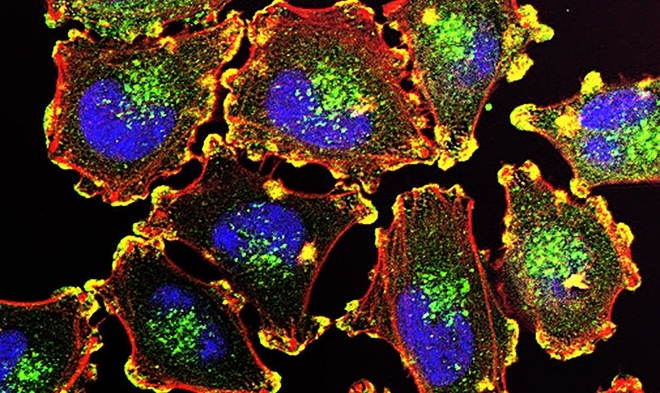

Study by scientists at the Center on Toxins, Immune-Response and Cell Signaling (CeTICS) paves the way for the identification of new cancer markers (melanoma cells / image: Julio Valencia – National Cancer Institute)
Study by scientists at the Center on Toxins, Immune-Response and Cell Signaling (CeTICS) paves the way for the identification of new cancer markers.
Study by scientists at the Center on Toxins, Immune-Response and Cell Signaling (CeTICS) paves the way for the identification of new cancer markers.

Study by scientists at the Center on Toxins, Immune-Response and Cell Signaling (CeTICS) paves the way for the identification of new cancer markers (melanoma cells / image: Julio Valencia – National Cancer Institute)
By Maria Fernanda Ziegler | Agência FAPESP – The identification of patterns in the expression of proteins secreted by melanoma cells may provide important pointers for the future development of biomarkers for use in detecting cancer and even determining the stage reached by the disease.
Brazilian researchers affiliated with the Federal University of São Paulo’s Science and Technology Center (ICT-UNIFESP) and with the Center on Toxins, Immune-Response and Cell Signaling (CeTICS), one of the Research, Innovation and Dissemination Centers (RIDCs) funded by FAPESP, have identified and analyzed 154 proteins expressed in melanoma cell lines and 209 other proteins expressed in metastatic cells. Patterns found in the molecules studied serve as signatures of the disease.
In an article published in Journal of Proteomics, the researchers describe a quantitative and qualitative analysis of protein expression (proteomics) in four different cell lines, focusing on the proteins secreted by healthy and malignant cells (secretomes).
The group performed a proteomic analysis of the secretomes derived from fibroblasts (connective tissue cells) from a metastatic site in the lungs of a patient with melanoma, skin fibroblasts from the same patient, and two malignant metastatic melanoma cell lines.
“We analyzed the expression patterns of the secreted proteins, i.e., the amount of a given protein in each cell line. The analysis clearly showed which patterns were characteristic of each type of cell as the proteins underwent alteration. Our ultimate goal is to use this discovery with other data to understand the development of cancer or prospect for markers associated with key processes in the disease,” said André Zelanis, principal investigator for the study, which is supported by FAPESP.
To reach their conclusions, the researchers compared normal and tumoral fibroblasts and metastatic cells, observing the biological processes involved in the initial stages of the development of cancer and in metastasis.
“The most distinctive aspect of our study was the inclusion of effectors, proteins that play key roles in the cellular system by triggering a response in the cell. Most studies that look for cancer biomarkers focus on the transcriptome, that portion of the genetic code that is transcribed into RNA molecules, analyzing mutated genes or which genes are expressed to a greater or lesser extent. These are important markers, but they aren’t necessarily reflected by altered levels of proteins because there isn’t a linear correlation between what’s transcribed and what will become protein. Our group looked for signatures of protein expression,” Zelanis told Agência FAPESP.
CSI of cancer
Zelanis explained that connective tissue cells such as fibroblasts secrete bioactive molecules, such as growth factors and protein-degrading enzymes (proteases), so they are often recruited by tumor cells to assist the progression of the cancer, leading to tumor growth and potentially to the spread of the cancer by metastasis.
“Our search for these signatures of expression was motivated by the idea that future biopsies could include analysis of the various cells to build an expression profile,” he said. “We don’t yet have a marker, but we have a set of molecules that point in a certain direction and provide important clues to carcinogenesis.”
Other research projects by the group have related aims. A master’s degree study by Francine Fontes Ricco Simões, supervised by Zelanis and supported by a scholarship from FAPESP, involves analyzing plasma samples from patients with melanoma treated at São Paulo State Cancer Institute (ICESP) to determine whether the signatures detected in the cell lines are also present in the bloodstream.
“We’re trying to cross-link the data from the study using cell lines and data from patients with different stages of melanoma,” Zelanis said. “We want to see if similar patterns occur and try to use them to identify the stage reached by the disease.”
Another of the group’s research lines entails sequencing the degradome, all the compounds produced in the degradation of proteases (enzymes that break down proteins and release protein fragments into the bloodstream).
“We have a research project designed to examine cell secretions in order to identify the substances produced by proteolytic processing and cleaved by a protease. The protein fragments enter the bloodstream and can be detected there. In the future, they may serve as markers that tell us whether a cancer has reached an advanced stage,” Zelanis said.
The article “Signatures of protein expression revealed by secretome analyses of cancer-associated fibroblasts and melanoma cell lines” (doi: 10.1016/j.jprot.2017.12.013) by Tarcísio Liberato, Dayelle S. Pessotti, Isabella Fukushima, Eduardo S. Kitano, Solange M.T. Serrano and André Zelanis can be retrieved from sciencedirect.com/science/article/pii/S1874391917304359?via%3Dihub.
Republish
The Agency FAPESP licenses news via Creative Commons (CC-BY-NC-ND) so that they can be republished free of charge and in a simple way by other digital or printed vehicles. Agência FAPESP must be credited as the source of the content being republished and the name of the reporter (if any) must be attributed. Using the HMTL button below allows compliance with these rules, detailed in Digital Republishing Policy FAPESP.





